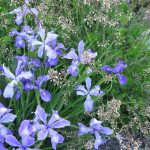Some Like It Dry
Count on iris for summer-dry gardens

Significant rain in early October is a boon to gardeners who value the fall gardening season. This goes in spades for those of us who … Continue reading
We've got issues.

Significant rain in early October is a boon to gardeners who value the fall gardening season. This goes in spades for those of us who … Continue reading
August went by in flash, as usual. Daily watering chores. Jam making. An ocean of applesauce. After a week’s vacation in a cabin by the Metolius, I somehow carved out time to think about the fall and winter vegetable garden. Space must be carved out, too, and I’m grateful for any crops that can go in after the pole beans and tomatoes are torn out in October. But starts of red Russian kale, my favorite for winter eating, need to go in as soon as possible. By October what you see is more or less what you get until growth starts up again in March. Continue reading
Not every garden in the Willamette Valley has super river-bottom silty loam. If your soil sets up like concrete when it’s dry it probably holds lots of moisture in the winter. Some wonderful summer blooming perennials have a problem with that. I’m thinking in particular of the many ravishing cultivars of agastache (ag-ah-STAK-ee) and salvia that have hit the market in recent decades. Lots of them need really good drainage to over-winter reliably in our region. Continue reading
A few weeks ago, I ran into Steve Solomon and Marina McShane at the Lane County Farmers Market. This meeting was remarkable for two reasons. One, Solomon, a guru of Northwest vegetable gardening and founder of Territorial Seed Company, has lived in Tasmania since 1998. Two, McShane had recently given me a copy of a book she and Solomon wrote together. Continue reading
A huge proportion of seed production in the U.S. (80 percent-plus) and around the world (40 percent-plus) is controlled by a handful of corporations such as Monsanto and DuPont. Should you care? That depends. Do you like to save your own vegetable seed? How do you feel about giant monopolies, genetic engineering and the idea of plants as intellectual property? Continue reading
Annuals rarely get a mention in books and articles on gardening with native plants. That’s too bad, because a succession of annual species can add a lot of color to your springtime garden, and attract pollinators, too. Flourishing plants of farewell-to-spring (Clarkia amoena) can bloom for many weeks — a happy thing, because it’s one of the showiest natives we have, and an eager self-sower. Mine escaped into a well-watered blueberry patch last year, providing months of gorgeous rose-pink flowers on bushy plants, not to mention abundant seed. Continue reading
Planning is one of the most important elements of gardening. It is also one of the easiest steps to overlook, especially for the beginner. Continue reading
The 2016 Lane County Propagation Fair will take place from 11 am to 4 pm Saturday and Sunday, March 26-27, at the old Whiteaker School, now the Whiteaker Head Start Building, 21 N. Grand Street. There will be outdoor workshops on a variety of topics on Sunday, March 27. This free annual event aims to promote local food security by supporting home orchardists, vegetable gardeners and native plant enthusiasts in and around the southern Willamette Valley. Continue reading
A search for escarole seed late last summer led me to the excellent website of Adaptive Seeds (adaptiveseeds.com). The seed they sent so promptly (for escarole “Diva” and a locally bred fava bean, “Aprovecho”) was terrific, delivering uniform, vigorous germination at a rate close to 100 percent. “Diva” has proved exceptionally cold-hardy, and the beans are growing strong. Continue reading
Most Willamette Valley gardeners know the popular native groundcover kinnikinnick (Arctostaphylos uva-ursi). Less familiar are larger members of the same genus known as manzanita. I fell in love with manzanitas when I visited a botanic garden in the Berkeley hills, where I saw mature specimens of several California species and could really appreciate the stems and bark that are their most striking feature. Continue reading